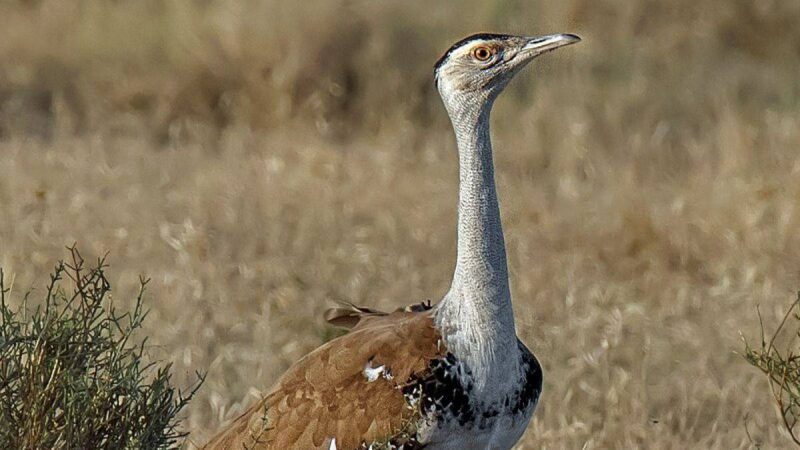In a recent development, wildlife officials in Rajasthan have launched a new strategy that will allow the Great Indian Bustard (GIB) to hatch and grow in the wild. The move comes as the GIB population has dropped to fewer than 200 at Rajasthan’s Desert National Park and parts of Gujarat. Read on to know more about this in detail.
Fewer Than 200 Great Indian Bustards Left In Rajasthan And Gujarat
As per Hindustan Times, the Great Indian Bustard’s (GIB) population, also known as the Godawan, has fallen rapidly to fewer than 200 birds in the wild. They are mostly found in Rajasthan’s Desert National Park (DNP) and parts of Gujarat. These critically endangered birds prefer grassland habitats and are known for their large size.
To increase their numbers, wildlife officials have now launched a new plan that allows them to hatch and grow naturally in the wild. The new strategy moves away from captive breeding at the Desert National Park centre. It aims to increase the GIB population in its natural surroundings while improving its survival instincts in the wild.
Also Read: 8 Wildlife Sanctuaries Around Nagpur To Spot Bengal Tigers, Sloth Bears, And Migratory Birds
Eggs To Be Hatched In The Wild
Earlier, officials at the wildlife park routinely collected Godawan eggs from enclosures and incubated them at the breeding centres. The chicks were raised in captivity. But now, as per HT, the eggs will be collected from the wild only for protection, and returned to their original nests just before hatching. This new strategy follows a recommendation by the Wildlife Institute of India.
Reportedly, Brijmohan Gupta, Deputy Conservator at the Divisional Forest Office (DFO) at DNP, confirmed the development. He explained that when a Godawan lays an egg in the open desert, wildlife teams discreetly replace it with a dummy egg that matches the real one in weight and appearance. The real egg is then sent to the breeding centre and incubated under controlled conditions to protect it from predators and harsh environmental conditions. When the egg is close to hatching, it is returned to its original nest, and the dummy is removed. This allows the chick to hatch and grow in its natural habitat, raised by its mother.
As per HT, the DNP team is working closely with scientists at the breeding centre to follow this new protocol. They have already collected two eggs from the Ramdevra region, which are currently under incubation. The wildlife team will carefully place them back in their nest once they are ready.
Also Read: 8 Best Places In The World To Spot Hummingbirds
Amazing, right? This strategy might help increase the number of these critically endangered birds in India. It could also improve their survival instincts in the wild. Just so you know, the Great Indian Bustard stands about a metre tall and weighs between 8 to 15 kg. It’s not just Rajasthan’s state bird but also one of the heaviest flying birds in the world!
Cover Image Courtesy: Great Indian Bustard, Wikipedia/ SVKMBFLY
For more such snackable content, interesting discoveries and the latest updates on food, travel and experiences in your city, download the Curly Tales App. Download HERE.
